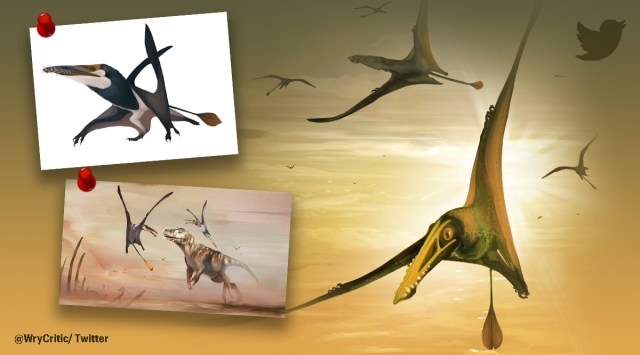Fossil of giant flying reptile discovered in Scotland
The spectacular fossil was discovered by Amelia Penny during a field trip in 2017. Penny spotted its jaw protruding from the limestone layer on a tidal platform.
 Pterosaurs were the first vertebrates to gain flying ability, even 50 million years before birds.
Pterosaurs were the first vertebrates to gain flying ability, even 50 million years before birds.A fossil of a huge flying reptile known as pterosaur from the Jurassic period has been discovered on the Isle of Skye in Scotland. The giant winged creature with an estimated wingspan of more than 2.5 metres lived around 170 million years ago, according to the University of Edinburgh website.
A research paper confirming the discovery was published recently in Current Biology by scientists from the University of Edinburgh, National Museums Scotland, the Hunterian Museum in Glasgow, the University of St Andrews and Staffin Museum on the Isle of Skye.
The creature has been named Dearc sgiathanach, meaning ‘winged reptile’ in Scottish Gaelic.
The spectacular fossil was discovered by Amelia Penny during a field trip in 2017. Penny spotted its jaw protruding from the limestone layer on a tidal platform. It was extracted after strenuous efforts and later investigated. CT scan of the skull showed that Dearc had large optic lobes suggesting good eyesight.
A spectacular fossil of a huge flying reptile, known as a #pterosaur, found by a @GeoSciences student on the Isle of Skye has been unveiled at @NtlMuseumsScot by PhD student Natalia Jagielska @WryCritic & @SteveBrusatte https://t.co/CZcDsCPsY0
— The University of Edinburgh (@EdinburghUni) February 22, 2022
Pterosaurs were the first vertebrates to gain flying ability, even 50 million years before birds. The discovery of Dearc has confirmed that pterosaurs grew to the size of fighter jets, just before the extinction of dinosaurs 66 million years ago. Meanwhile, they were earlier believed to be smaller during the Jurassic period.
Since then, Penny’s Twitter account has been flooded with applause for her discovery and sketches of Dearc.
A quick sketch of Dearc sgiathanach, the new large Jurassic pterosaur recently described by @WryCritic. Not very happy with this drawing (though to be generous with myself this is only the second pterosaur I’ve ever drawn) but it was fun nonetheless. pic.twitter.com/IyNNoa1zeR
— Dan King (@TheDJ_King) February 23, 2022
Congrats @WryCritic and everyone else who worked on unearthing and analyzing this beautiful new lad!!!! #dearcsgiathanach pic.twitter.com/LbxbfXCV1X
— Dani Mays ~COMMISSIONS OPEN~ (@Dani_M_Art) February 23, 2022
BREAKING: Experts have revealed that remains of the world’s biggest Jurassic-era pterodactyl – the size of an albatross and dating back around 170 million years – have been discovered on the Isle of Skye. https://t.co/TWfxbyQ8J1 @TheScotsman @NtlMuseumsScot @EdinburghUni pic.twitter.com/VojDjMRNo0
— Brian Ferguson (@brianjaffa) February 22, 2022
University of Edinburgh website quoted Natalia Jagielska from the School of GeoSciences as saying, “Dearc is a fantastic example of why palaeontology will never cease to be astounding. Pterosaurs preserved in such quality are exceedingly rare and are usually reserved to select rock formations in Brazil and China. And yet, an enormous superbly preserved pterosaur emerged from a tidal platform in Scotland.”
Jagielska added, “To achieve flight, pterosaurs had hollow bones with thin bone walls, making their remains incredibly fragile and unfit to preserving for millions of years. And yet our skeleton, ~160 million years on since its death, remains in almost pristine condition, articulated and almost complete. Its sharp fish-snatching teeth still retaining a shiny enamel cover as if he were alive mere weeks ago.”
“This is a superlative Scottish fossil. The preservation is amazing, far beyond any pterosaur ever found in Scotland and probably the best British skeleton found since the days of Mary Anning in the early 1800s. Dearc is the biggest pterosaur we know from the Jurassic period and that tells us that pterosaurs got larger much earlier than we thought, long before the Cretaceous period when they were competing with birds, and that’s hugely significant,” Professor Steve Brusatte from the School of GeoSciences was quoted as saying by University of Edinburgh website.
- 01
- 02
- 03
- 04
- 05































